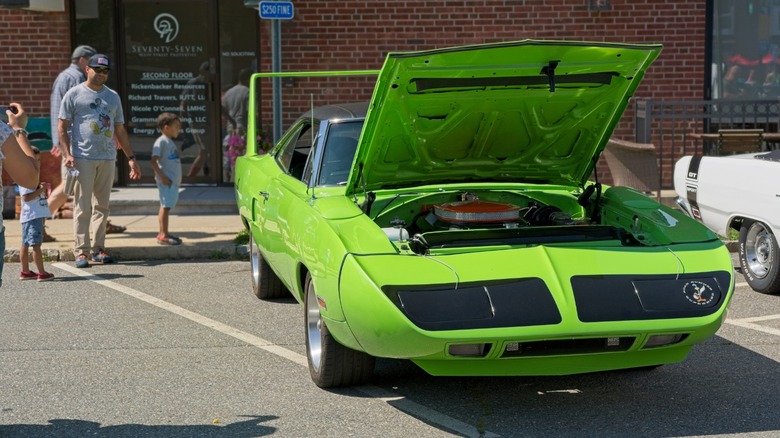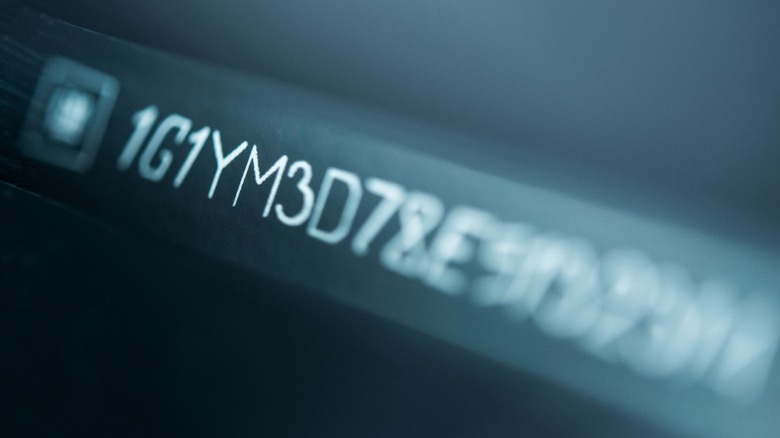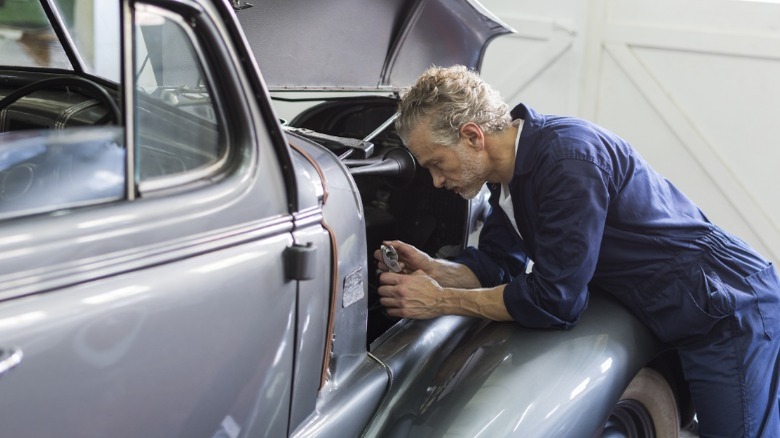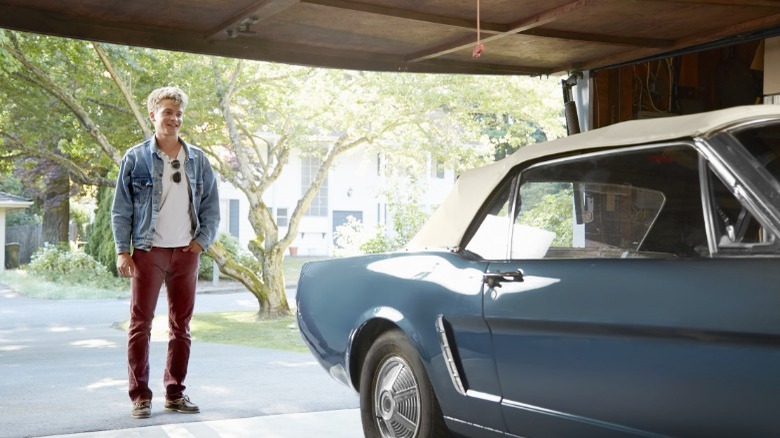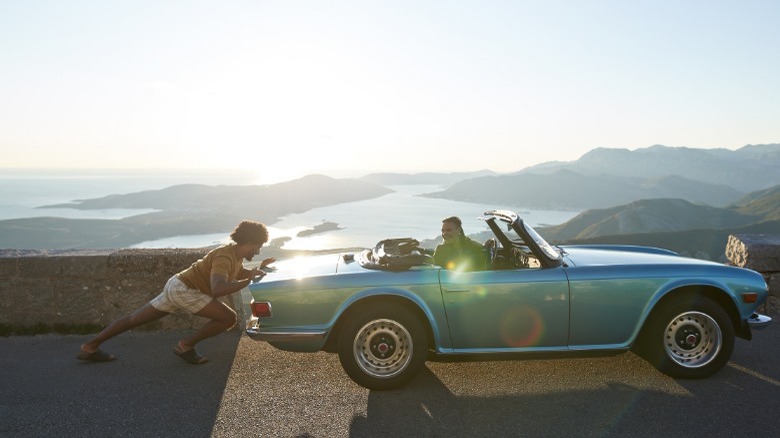5 Mistakes To Avoid When Buying A Classic Car
Buying a classic car can be an exhilarating experience — not to mention a solid investment. For one, older vehicles may be easier to work on and restore than contemporary cars, thanks to their lack of modern electrical systems and advanced safety equipment. Vintage vehicles typically have large, open engine bays with simple carbureted motors. Older cars may also have less complex equipment overall, including transmissions, suspension systems, and steering gears that are easier to tinker with than the components found in modern vehicles.
But it's not all sunshine and rainbows when it comes to buying and working on a classic car. Vintage vehicles come with challenges. First of all, it can be hard to source parts for classic cars, especially extremely rare ones. Second, for younger people that grew up in the age of fuel injection and modern electronics, older vehicles with carbureted engines can feel foreign. And those are only some of the obstacles you'll have to overcome once you already own an antique vehicle. Buying a classic car is a different beast entirely, and it's easy to make mistakes when shopping for a vintage set of wheels.
Fortunately, we can help with that. As a former professional automotive repair technician and a lifelong car enthusiast, I'll help guide you through the process and break down some of the most common mistakes people make when shopping for classic cars. I'll touch on everything from the research you need to do beforehand to how to inspect a vintage vehicle before forking over your hard-earned cash. So, let's go ahead and dive in and explore five common mistakes you need to avoid when buying a classic car.
Not doing enough research
One of the biggest mistakes people often make when buying a classic car is failing to do their homework. That research largely boils down to understanding the ins and outs of the vintage vehicle you plan to buy, both in terms of model information like engine displacement and transmission type, as well as your chosen car's current condition and the type of work it will need. That even applies to classic cars that are already in pristine condition — even if you're buying a vehicle that someone else has already restored, it's important that you research the make and model to determine what a fair price looks like and whether or not the vehicle will be a solid investment.
If the classic car you plan to buy is not already restored and in good condition, your journey will be substantially more involved. You'll need to understand what repairs the vehicle requires, how and where to source antique parts or acceptable replicas, and the time/financial commitment that restoring the car demands. Failing to have a firm grasp of those factors can not only result in a huge shock to your wallet, but it may also transform your project from an enjoyable experience into a full-blown nightmare.
Forgetting to check the VIN
Another fairly common and critical mistake that people make when buying a classic car is forgetting to check the vehicle identification number (VIN). It's an easy mistake as most people aren't accustomed to checking the VIN before purchasing a used vehicle. However, checking the VIN is vital when it comes to buying classic cars due to their age and the lack of detailed history that these vehicles often have.
Compared to shopping for a used modern vehicle, it's not always possible to find CarFax reports and maintenance records for classic cars. Instead, we have to rely on the VIN. And that doesn't mean just checking the VIN in one area. It's crucial that you check to confirm that the VIN stamped on your vintage vehicle's door jamb, dashboard, and engine all match up. You should also look your model up online to determine any other locations on the car where the VIN is stamped. Doing so will help you avoid buying a Frankenstein vehicle, as authentic cars, with all or most of their original parts — especially the engine — are substantially more valuable than those that have been pieced together over the years. Now, if you're buying a classic vehicle to turn into a custom race car or have other plans that involve replacing most of the stock parts with aftermarket components, this may be less important. That said, the VIN is always a vital piece of information, and checking it can even help you avoid buying a stolen vehicle or one with an otherwise shady past.
Skipping the inspection
Failing to get an inspection is something that many used car shoppers are guilty of doing — not just in buying a classic car. But the fact that many people decide to skip a pre-purchase inspection doesn't make it any less of a mistake. In reality, inspecting the vehicle beforehand is one of the most important things you need to do when shopping for a used car. Even if you plan to buy a fully restored classic car, it's important to have a professional give it a quick once-over before you hand over the cash. Doing so can provide you with peace of mind and help you avoid any unexpected flaws or financial expenditures.
You have a few options when it comes to getting a pre-purchase inspection. If you're an experienced mechanic or extremely knowledgeable in the area of classic cars, you can perform the inspection yourself. If you're not a veteran car person, your best move is to hire a professional to come with you to check out the car. That may translate to visiting your local auto repair shop and asking what they'd charge for this service, looking for a vintage vehicle expert in your area who specializes in evaluating and appraising classic cars or reaching out to a knowledgeable friend.
When performing the inspection, there are a few critical areas to which you should pay close attention. That includes looking for obvious signs of rust on both the frame and floorboards, inspecting the engine for leaks and damage, and performing a test drive if possible. The pre-purchase inspection is also the best time to check the VIN and make sure it matches the other stamped components.
Failing to understand long-term costs
Another mistake that's easy to make when buying a classic car is failing to account for the long-term costs of vintage vehicle ownership. Planning for the up-front expenses is only the first step when it comes to purchasing a classic car. If you're planning to buy an antique vehicle, you can't forget about long-term expenses like maintenance, storage, and insurance fees.
Your classic car will most likely not come with a manufacturer's warranty or a set maintenance schedule, meaning you may pay more for routine services like oil replacements, alignments, and tire changes than what it costs to perform those services on modern vehicles. Instead of visiting a dealership, where you'll probably pay inflated repair and labor fees, you should search for a reputable independent shop that specializes in working on older vehicles. If you perform your own repairs and maintenance, you can usually disregard those concerns. However, you still need to remember that parts for antique cars may be more expensive and harder to find than those for modern vehicles.
Outside of repairs and maintenance, you'll need to consider how you're going to store your classic car. You probably don't want to leave your vintage vehicle sitting out exposed to the elements, especially if it's fully restored. If you don't have adequate garage space at home, you may need to pay to store your classic car somewhere. Finally, it's important to remember insurance fees. Your vintage vehicle is an investment, and you need to protect it — not to mention that it's illegal to drive without insurance in most places. Depending on the type of vintage car, classic car insurance costs can be pricey. It's vital that you're prepared to handle all of these expenses before diving into the world of classic car ownership.
Letting dreams cloud judgment
Another mistake that's very easy to make when buying a classic car is allowing your dreams to cloud your judgment. This single error can lead to each of the previous mistakes discussed here. A lot of people get so excited by the possibility of owning a vintage vehicle that they forget to exercise caution and follow the proper steps. It's easy to fall in love with the first car you find, especially if it appears to check all of the boxes in terms of what you're looking for in an antique vehicle. However, it's vital to remember to take the proper precautions, as failing to do so can result in a lot of negative consequences.
One way to help yourself avoid making this mistake is to refrain from buying a car the minute you see it. Even if the vehicle seems like it's in perfect condition and the price feels right, you should at least take a day or two to sleep on your decision and revisit the purchase with fresh eyes. Taking that time will also allow you to do a little bit more research to discover if the asking price is, in fact, a fair deal and whether any necessary parts will be easy to acquire. It's understandable that you may be afraid of missing out on a great offer. But it's important to remember that deals come and go and to exercise caution to protect your wallet and your sanity.
